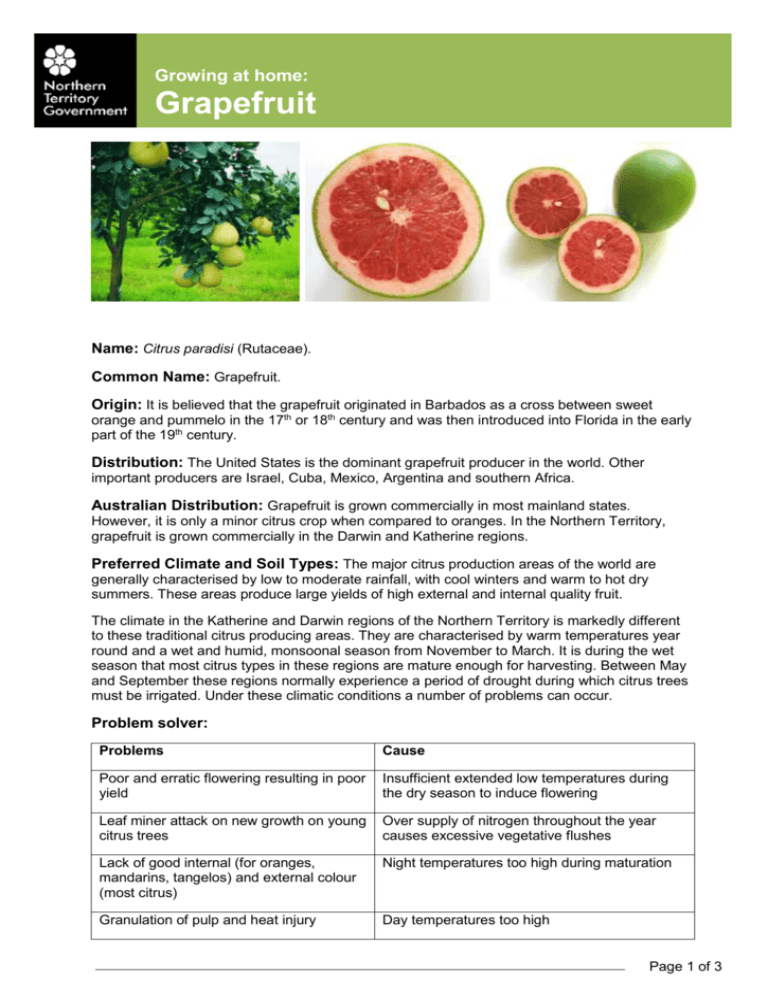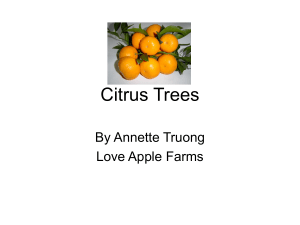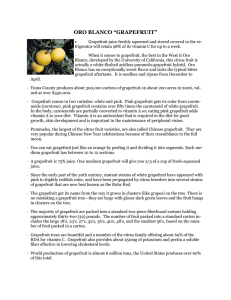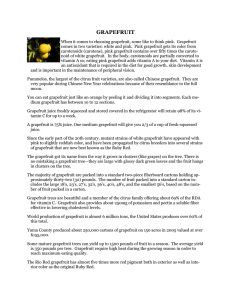Growing at home- Grapefruit - Northern Territory Government
advertisement

Growing at home: Grapefruit Name: Citrus paradisi (Rutaceae). Common Name: Grapefruit. Origin: It is believed that the grapefruit originated in Barbados as a cross between sweet orange and pummelo in the 17th or 18th century and was then introduced into Florida in the early part of the 19th century. Distribution: The United States is the dominant grapefruit producer in the world. Other important producers are Israel, Cuba, Mexico, Argentina and southern Africa. Australian Distribution: Grapefruit is grown commercially in most mainland states. However, it is only a minor citrus crop when compared to oranges. In the Northern Territory, grapefruit is grown commercially in the Darwin and Katherine regions. Preferred Climate and Soil Types: The major citrus production areas of the world are generally characterised by low to moderate rainfall, with cool winters and warm to hot dry summers. These areas produce large yields of high external and internal quality fruit. The climate in the Katherine and Darwin regions of the Northern Territory is markedly different to these traditional citrus producing areas. They are characterised by warm temperatures year round and a wet and humid, monsoonal season from November to March. It is during the wet season that most citrus types in these regions are mature enough for harvesting. Between May and September these regions normally experience a period of drought during which citrus trees must be irrigated. Under these climatic conditions a number of problems can occur. Problem solver: Problems Cause Poor and erratic flowering resulting in poor yield Insufficient extended low temperatures during the dry season to induce flowering Leaf miner attack on new growth on young citrus trees Over supply of nitrogen throughout the year causes excessive vegetative flushes Lack of good internal (for oranges, mandarins, tangelos) and external colour (most citrus) Night temperatures too high during maturation Granulation of pulp and heat injury Day temperatures too high Page 1 of 3 Grow at home: Grapefruit The tropical climate, however, is conducive to fast growing, early maturing citrus trees. With proper management, this may enable the NT citrus industry to produce fruit for particular market windows. In southern Australia, grapefruit flower in spring and fruit matures after 12 to 14 months. In the tropics, flowering may occur as early as July with fruit maturing six months later. Citrus trees will grow in a wide range of soil types. They will grow best in soils of a medium texture, moderate depth, good drainage, high fertility, slightly acid pH and low in soluble salts. If soils do not meet these criteria, citrus may still be grown, although more care in cultural practices will be required. Description: The grapefruit tree is evergreen and small. Tree size will depend on the environment, the cultivar and the management. The leaves are often large and oval in shape, glossy green in colour, are dotted with oil glands and have broadly winged petioles (leaf stalks). The flowers are white, large, fragrant, and may be either solitary or clustered in the leaf axils. Branches sometimes have spines but these tend to be flexible, slender and blunt. Varieties: In southern regions of Australia, traditionally the white grapefruit cultivar Marsh was mainly grown. In this cooler climate, the grapefruit tends to be acidic in flavour. When grown under tropical conditions this same grapefruit cultivar tends to be less acidic and more pleasant to eat. However, in recent years, the preference in the market place has changed from whitefleshed cultivars to pigmented (pink and red fleshed) cultivars. The red pigment (lycopene) in these pigmented grapefruit is enhanced by high temperatures and these cultivars appear to be well suited to the Katherine and Darwin regions of the Northern Territory. There are a number of pigmented cultivars available but "Rio Red", "Flame" and "Star Ruby" are mainly grown in these regions. There are also a number of "Ruby" trees planted, but these were some of the earlier plantings and the later plantings are being made with the other cultivars. Culture: Seedling trees of citrus tend to be vigorous and thorny, take a long time to fruit and generally produce poor quality fruit. To overcome these problems grafted trees should be planted. Grafted trees consist of at least two distinct individuals, the scion and the rootstock. The scion is the fruiting part of the tree and is material selected from mother trees of the required cultivar. The rootstock is the bottom part of the tree. The rootstock can influence the performance of the tree in a number of ways: - Tree shape and size - Yield - Maturity times - Size and colour of the fruit - Adaptability of the tree to certain soils and climates - Resistance of the tree against diseases. Therefore, a rootstock needs to be chosen that suits the requirements of the grower. Grafted trees should be sourced from accredited nurseries so as to ensure that the trees are disease free and true to type. The management requirements for citrus in the tropics are different to that in southern regions. This is due to the different growth patterns of the trees. There are an increased number of flushes on trees in the tropics. Therefore trees need to be pruned from a younger age to ensure good branch structure and to minimise tree size. Trees need to be irrigated when the rain has stopped. The timing of nitrogen application in the tropics is important. If it is applied at the wrong time it may induce unwanted vegetative flushes. Also deficiencies of micronutrients (zinc and manganese) are quite common, particularly in the Katherine region, due to high soil pH. Regular applications of foliar sprays of these elements to young flushes will correct this. Pests and Diseases: In the Katherine and Darwin regions of the Northern Territory, citrus leaf miner (Phyllocnistis citrella) is particularly a problem on young trees and it can slow tree Page 2 of 3 Grow at home: Grapefruit development. Red scale (Aonidiella aurantii) can also be a problem on trees and if not controlled it can lead to the death of branches and trees. Oriental spider mite (Eutetranychus orientalis) is quite prevalent during the wet season and can cause the trees to become unthrifty. If grapefruits are left to ripen on the tree then fruit piercing moth (Othreis sp.) damage can occur. Root rots and collar rots caused by Phytophthora sp. can occur on trees grown in areas prone to waterlogging. By choosing appropriate rootstocks and growing trees on sites which are well drained will help to minimise the occurrence of these problems. Fruiting Season: The fruiting season will depend on the microclimate, the management, and the cultivar. In backyard situations the trees may flower and fruit all year around. In commercial situations, the timing of irrigation and fertiliser application may be used to manipulate the timing of flowering and fruiting to target market windows. However, in the Darwin and Katherine regions the main production period is from the middle of February to the end of April. While in the Alice Springs region the production period is from early April to the end of May. Harvesting: In southern Australia, mature fruit may be stored on the tree for several months. However, in northern Australia they rapidly become over-mature and develop puffy skins, hollow centres and off-flavours unless harvested when mature. Determining when the fruit is mature by visual inspection is difficult in tropical environments. This is because the fruit may have a green external colour, even though its internal quality is acceptable to the market place. Therefore, in commercial situations, fruit should be sampled randomly and tested to determine when to harvest. Once the size of the fruit, the juice content and the sugar to acid ratio meet market standards, the fruit should be harvested. It is then "degreened" using ethylene gas. "Degreening" involves breaking down the green pigment in the fruit (chlorophyll) so that the other underlying pigments become visible. Storage Conditions: With proper treatment and storage facilities it should be possible to cold-store grapefruit at 12°C for about three months. Culinary Use: The juice and the flesh of the grapefruit have traditionally been popular as part of breakfast. However, they are also used to flavour and garnish food. Plant Industries, Department of Primary Industry and Fisheries GPO Box 3000, Darwin NT 0801 [Normal] Telephone: 08 8999 2292 Facsimile: 08 8999 2049 Email: horticulture@nt.gov.au Web: www.horticulture.nt.gov.au Disclaimer: While all care has been taken to ensure that information contained in this information sheet is true and correct at the time of publication, the Northern Territory of Australia gives no warranty or assurance, and makes no representation as to the accuracy of any information or advice contained in this publication, or that it is suitable for your intended use. No serious, business or investment decisions should be made in reliance on this information without obtaining independent and/or professional advice in relation to your particular situation. Page 3 of 3









